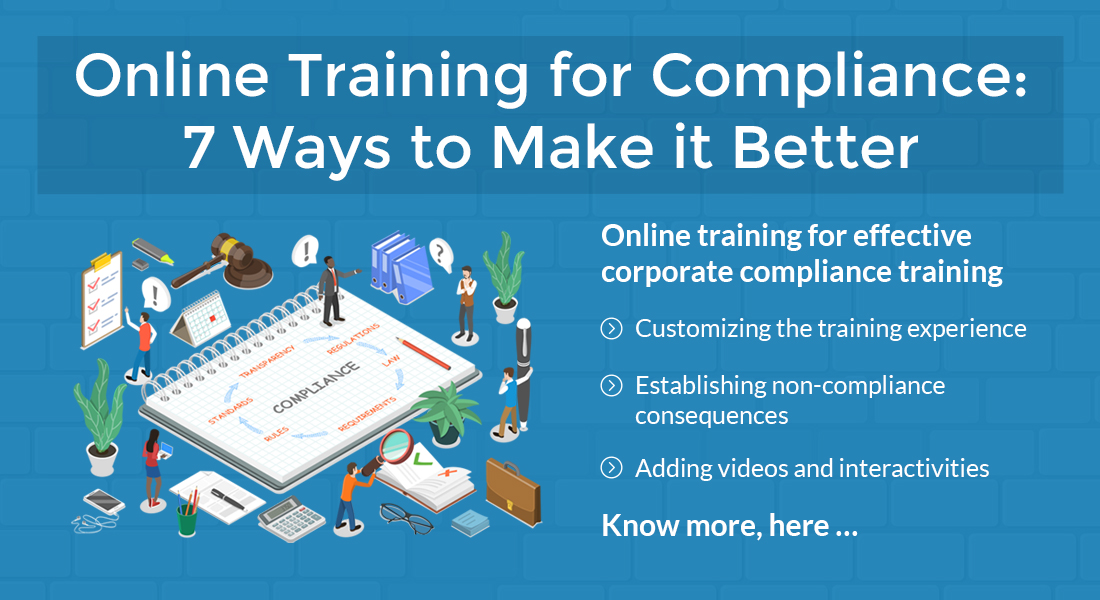From Whoa to Wow! 5 Tips for Effective Online Compliance Training

Initiating and delivering effective compliance training programs has become one of the key priorities of all organizations, irrespective of their size and industry. Designing an effective compliance training program is important as it safeguards the organization against all legal and ethical obligations.
5 Tips to Deliver Effective Online Compliance Training
- Understand your audience
- Focus on one learning objective at a time
- Use interactivities
- Incorporate real examples
- Give clear feedback
But, when you talk about compliance training, employees may feel it is boring, time consuming and has dry content. However, we can actually create an engaging and effective compliance training using the following tips.
→ Download Now: State of Learning (Now and Beyond) [eBook]
Tips to Deliver Effective Online Compliance Training
1. Know your audience
Before assigning compliance training, it is important to know about the audience who is going to take the training. Knowing about their education, experience in the industry and skill set will help you a lot in designing and assigning the compliance training. We can get all this data through a quick online survey, interviews or even by just observing them on the job.

This data is helpful in assigning the same compliance training to similar sets or groups of employees and also adds value in altering the compliance training programs with the appropriate elearning tools and design elements.
2. Focus on a single objective and build simple modules
Compliance training objective has to be defined clearly; employees must know the purpose of the training and the relevant information to comply with the rules. It is better NOT to set too many objectives in one place and expect employees to achieve them. At the same time, the assigned compliance training must educate employees on the statues, regulations and laws they need to follow while working.
Lengthy modules are difficult to understand and make employees feel disengaged most of the time. It is also hard to retain what they have learnt if the content is huge and technical. Hence, it is important to divide training curriculum into digestible modules with key points.

A Bird’s Eye View of What Top-Performing L&D Teams are Doin
- Aligning Learning Strategy with Business Strategy
- Developing Business Skills for the Future
- Investing in the Right Technology
- Much More
3. Use interactivities
One of the good strategies to design effective compliance training is to use interactivities, games and simulations in the course. This is the best way to involve employees in the training and retain what they have learnt. Integrating videos to explain legal issues also can engage employees more and help them absorb the training.
Incorporating a character into the compliance training can offer interactivity and retention at the same and make the training effective and engaging.
4. Educate them with real and relevant examples
Compliance training must include real scenarios, case studies and consequences to understand the kind of risks associated with the regulations and laws. Employees will not ignore the training once they come across complex issues and the consequences of failing to follow the rules.
It is necessary to convey their actions and decisions matter when they are working. This way, they will feel more responsible and committed towards their work once they finish the training.
5. Give quick feedback and clear dos and don’ts
It is important to give quick feedback to employees about their training progress frequently. Having small quizzes to check the understanding and sharing results will encourage them to complete the training.
Also, it is helpful to employees if we provide a list of dos and don’ts for all likely situations. This document can also be a reference manual to check whenever they are in doubt.
Thus, the above tips are useful in designing effective compliance training programs. Do share your views.
Editor’s Note: This post was originally published in October 2011 and has been completely revamped and updated for accuracy and comprehensiveness.





